Numerical Study to Enhance the Sensitivity of a Surface Plasmon Resonance Sensor with BlueP/WS2-Covered Al2O3-Nickel Nanofilms
Abstract
:1. Introduction
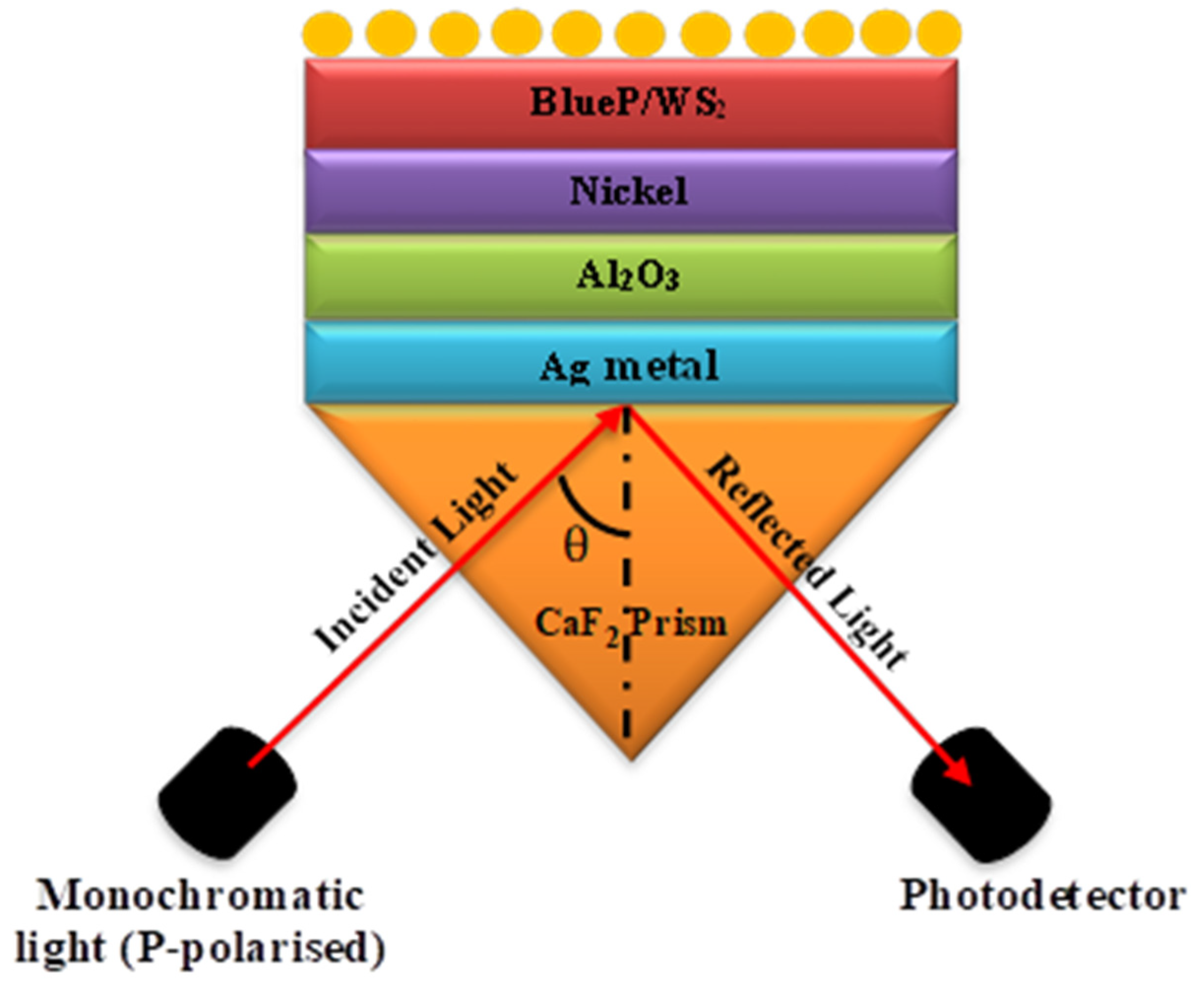
2. Mathematical Modeling for the Proposed SPR Biosensor
2.1. Device Structure
2.2. Mathematical Expression for Reflectivity
3. Results and Discussion
3.1. Use of CaF2 Crystal
3.2. Performance Constraints of the SPR Sensor
3.3. Sensitivity (S)
3.4. Quality Factor (QF)
3.5. Full Width at Half Maximum (FWHM)
3.6. Detection Accuracy (DA)
3.7. Limit of Detection (LOD)
3.8. The Impact of the Refractive Index on the Reflectance Curves of Different SPR Sensor Structures
3.9. Optimization of the Thicknesses of Al2O3 and Metal (Ni)
3.10. Parameter Analysis of the Projected SPR Biosensor
3.11. Clarification of Transvers Magnetic (TM) Field and Penetration Depth
4. Conclusions
Author Contributions
Funding
Data Availability Statement
Acknowledgments
Conflicts of Interest
References
- Schuller, J.A.; Barnard, E.; Cai, W.; Jun, Y.C.; White, J.S.; Brongersma, M.L. Plasmonics for extreme light concentration and manipulation. Nat. Mater. 2010, 9, 193–204. [Google Scholar] [CrossRef] [PubMed]
- Gramotnev, D.K.; Bozhevolnyi, S.I. Plasmonics beyond the diffraction limit. Nat. Photonics 2010, 4, 83–91. [Google Scholar] [CrossRef]
- Zhixun, L.; Yunying, S.; Yunfei, Y.; Yuanyuan, F.; Lvqing, B. Electro-Optic Hybrid Logic Gate Derived from a Silicon-Based Hybrid Surface Plasmon Polariton Waveguide. J. Nanoelectron. Optoelectron. 2022, 17, 298–304. [Google Scholar] [CrossRef]
- Mao, Y.; Zhu, Y.; Jia, C.; Zhao, T.; Zhu, J. A Self-Powered Flexible Biosensor for Human Exercise Intensity Monitoring. J. Nanoelectron. Optoelectron. 2021, 16, 699–706. [Google Scholar] [CrossRef]
- Syubaev, S.A.; Zhizhchenko, A.Y.; Pavlov, D.; Gurbatov, S.O.; Pustovalov, E.V.; Porfirev, A.P.; Khonina, S.N.; Kulinich, S.; Rayappan, J.B.B.; Kudryashov, S.I.; et al. Plasmonic Nanolenses Produced by Cylindrical Vector Beam Printing for Sensing Applications. Sci. Rep. 2019, 9, 19750. [Google Scholar] [CrossRef] [Green Version]
- Yi, Z.; Liang, C.; Chen, X.; Zhou, Z.; Tang, Y.; Ye, X.; Yi, Y.; Wang, J.; Wu, P. Dual-Band Plasmonic Perfect Absorber Based on Graphene Metamaterials for Refractive Index Sensing Application. Micromachines 2019, 10, 443. [Google Scholar] [CrossRef] [Green Version]
- Tabassum, R.; Kant, R. Recent trends in surface plasmon resonance based fiber–optic gas sensors utilizing metal oxides and carbon nanomaterials as functional entities. Sens. Actuators B Chem. 2020, 310, 127813. [Google Scholar] [CrossRef]
- Saad, Y.; Selmi, M.; Gazzah, M.H.; Bajahzar, A.; Belmabrouk, H. Performance enhancement of a cop-per-based optical fiber SPR sensor by the addition of an oxide layer. Optik 2019, 190, 19. [Google Scholar] [CrossRef]
- Homola, J.; Yee, S.S.; Gauglitz, G. Surface plasmon resonance sensors. Sens. Actuators B Chem. 1999, 54, 3–15. [Google Scholar] [CrossRef]
- Kim, S.-K. Computational Sub-10 nm Plasmonic Nanogap Patterns by Block Copolymer Self-Assembly. J. Nanoelectron. Optoelectron. 2021, 16, 1063–1066. [Google Scholar] [CrossRef]
- Kowalczyk, S.W.; Tuijtel, M.; Donkers, S.P.; Dekker, C. Unraveling Single-Stranded DNA in a Solid-State Nanopore. Nano Lett. 2010, 10, 1414–1420. [Google Scholar] [CrossRef]
- West, P.; Ishii, S.; Naik, G.; Emani, N.K.; Shalaev, V.; Boltasseva, A. Searching for better plasmonic materials. Laser Photon-Rev. 2010, 4, 795–808. [Google Scholar] [CrossRef] [Green Version]
- Naik, G.V.; Shalaev, V.M.; Boltasseva, A. Alternative Plasmonic Materials: Beyond Gold and Silver. Adv. Mater. 2013, 25, 3264–3294. [Google Scholar] [CrossRef] [PubMed]
- Maurya, J.B.; Prajapati, Y.K.; Singh, V.K.; Saini, J.P.; Tripathi, R. Performance of graphene–MoS2 based surface plasmon resonance sensor using Silicon layer. Opt. Quantum Electron. 2015, 47, 3599–3611. [Google Scholar] [CrossRef]
- Prajapati, Y.K.; Pal, S.; Saini, J.P. Effect of a Metamaterial and Silicon Layers on Performance of Surface Plasmon Resonance Biosensor in Infrared Range. Silicon 2018, 10, 1451–1460. [Google Scholar] [CrossRef]
- Xiao, L.; Youji, L.; Feitai, C.; Peng, X.; Ming, L. Facile synthesis of mesoporous titanium dioxide doped by Ag-coated graphene with enhanced visible-light photocatalytic performance for methylene blue degradation. RSC Adv. 2017, 7, 25314–25324. [Google Scholar] [CrossRef] [Green Version]
- Tang, N.; Li, Y.; Chen, F.; Han, Z. In situ fabrication of a direct Z-scheme photocatalyst by immobilizing CdS quantum dots in the channels of graphene-hybridized and supported mesoporous titanium nanocrystals for high photocatalytic performance under visible light. RSC Adv. 2018, 8, 42233–42245. [Google Scholar] [CrossRef] [Green Version]
- Zhang, X.; Teng, S.Y.; Loy, A.C.M.; How, B.S.; Leong, W.D.; Tao, X. Transition Metal Dichalcogenides for the Application of Pollution Reduction: A Review. Nanomaterials 2020, 10, 1012. [Google Scholar] [CrossRef]
- Sharma, N.K. Performances of different metals in optical fibre-based surface plasmon resonance sensor. Pramana 2012, 78, 417–427. [Google Scholar] [CrossRef]
- Ordal, M.A.; Bell, R.J.; Alexander, R.W.; Long, L.L.; Querry, M.R. Optical properties of fourteen metals in the infrared and far infrared: Al, Co, Cu, Au, Fe, Pb, Mo, Ni, Pd, Pt, Ag, Ti, V, and W. Appl. Opt. 1985, 24, 4493–4499. [Google Scholar] [CrossRef]
- Ehrenreich, H.; Philipp, H.R.; Olechna, D.J. Optical Properties and Fermi Surface of Nickel. Phys. Rev. (Ser. I) 1963, 131, 2469–2477. [Google Scholar] [CrossRef]
- Shukla, S.; Sharma, N.K.; Sajal, V. Theoretical Study of Surface Plasmon Resonance-based Fiber Optic Sensor Utilizing Cobalt and Nickel Films. Braz. J. Phys. 2016, 46, 288–293. [Google Scholar] [CrossRef]
- Peng, Q.; Wang, Z.; Sa, B.; Wu, B.; Sun, Z. Electronic structures and enhanced optical properties of blue phosphorene/transition metal dichalcogenides van der Waals heterostructures. Sci. Rep. 2016, 6, 31994. [Google Scholar] [CrossRef] [PubMed] [Green Version]
- Chen, H.; Chen, Z.; Yang, H.; Wen, L.; Yi, Z.; Zhou, Z.; Dai, B.; Zhang, J.; Wu, X.; Wu, P. Multi-mode surface plasmon resonance absorber based on dart-type single-layer graphene. RSC Adv. 2022, 12, 7821–7829. [Google Scholar] [CrossRef]
- Long, F.; Zhang, Z.; Wang, J.; Yan, L.; Zhou, B. Cobalt-nickel bimetallic nanoparticles decorated graphene sensitized imprinted electrochemical sensor for determination of octylphenol. Electrochimica Acta 2015, 168, 337–345. [Google Scholar] [CrossRef]
- Wu, X.; Zheng, Y.; Luo, Y.; Zhang, J.; Yi, Z.; Wu, X.; Cheng, S.; Yang, W.; Yu, Y.; Wu, P. A four-band and polarization-independent BDS-based tunable absorber with high refractive index sensitivity. Phys. Chem. Chem. Phys. 2021, 23, 26864–26873. [Google Scholar] [CrossRef]
- Alagdar, M.; Yousif, B.; Areed, N.F.; Elzalabani, M. Highly sensitive fiber optic surface plasmon resonance sensor employing 2D nanomaterials. Appl. Phys. A 2020, 126, 522. [Google Scholar] [CrossRef]
- Naresh, V.; Lee, N. A Review on Biosensors and Recent Development of Nanostructured Materials-Enabled Biosensors. Sensors 2021, 21, 1109. [Google Scholar] [CrossRef]
- Hasib, M.H.H.; Nur, J.N.; Rizal, C.; Shushama, K.N. Improved Transition Metal Dichalcogenides-Based Surface Plasmon Resonance Biosensors. Condens. Matter 2019, 4, 49. [Google Scholar] [CrossRef] [Green Version]
- Gupta, B.; Sharma, A.K. Sensitivity evaluation of a multi-layered surface plasmon resonance-based fiber optic sensor: A theoretical study. Sens. Actuators B Chem. 2005, 107, 40–46. [Google Scholar] [CrossRef]
- Ouyang, Q.; Zeng, S.; Jiang, L.; Qu, J.; Dinh, X.-Q.; Qian, J.; He, S.; Coquet, P.; Yong, K.-T. Two-Dimensional Transition Metal Dichalcogenide Enhanced Phase-Sensitive Plasmonic Biosensors: Theoretical Insight. J. Phys. Chem. C 2017, 121, 6282–6289. [Google Scholar] [CrossRef]
- Shah, K.; Sharma, N.K. SPR based Fiber Optic Sensor Utilizing Thin Film of Nickel. In AIP Conference Proceedings; AIP Publishing LLC: College Park, MD, USA, 2018; Volume 2009, p. 020040. [Google Scholar]
- Han, L.; Hu, Z.; Pan, J.; Huang, T.; Luo, D. High-sensitivity goos-hänchen shifts sensor based on bluep-tmdcs-graphene heterostructure. Sensors 2020, 20, 3605. [Google Scholar] [CrossRef] [PubMed]
- Tabassum, R.; Mishra, S.K.; Gupta, B.D. Surface plasmon resonance-based fiber optic hydrogen sulphide gas sensor utilizing Cu–ZnO thin films. Phys. Chem. Chem. Phys. 2013, 15, 11868–11874. [Google Scholar] [CrossRef] [PubMed]
- Yamamoto, M. Surface plasmon resonance (SPR) theory: Tutorial. Rev. Polarogr. 2002, 48, 209–237. [Google Scholar] [CrossRef]
- Verma, R.; Gupta, B.D.; Jha, R. Sensitivity enhancement of a surface plasmon resonance based biomolecules sensor using graphene and silicon layers. Sens. Actuators B Chem. 2011, 160, 623–631. [Google Scholar] [CrossRef]
- Vasimalla, Y.; Pradhan, H.S. Modeling of a novel K5 prism-based surface Plasmon resonance sensor for urea detection employing Aluminum arsenide. J. Opt. 2022, 1–12. [Google Scholar] [CrossRef]
- Meshginqalam, B.; Barvestani, J. Performance Enhancement of SPR Biosensor Based on Phosphorene and Transition Metal Dichalcogenides for Sensing DNA Hybridization. IEEE Sens. J. 2018, 18, 7537–7543. [Google Scholar] [CrossRef]
- Sharma, A.K.; Kaur, B. Analyzing the effect of graphene’s chemical potential on the performance of a plasmonic sensor in infrared. Solid State Commun. 2018, 275, 58–62. [Google Scholar] [CrossRef]
- AlaguVibisha, G.; Nayak, J.K.; Maheswari, P.; Priyadharsini, N.; Nisha, A.; Jaroszewicz, Z.; Rajesh, K.; Jha, R. Sensitivity enhancement of surface plasmon resonance sensor using hybrid configuration of 2D materials over bimetallic layer of Cu–Ni. Opt. Commun. 2020, 463, 125337. [Google Scholar] [CrossRef]
- Alagdar, M.; Yousif, B.; Areed, N.F.; ElZalabani, M. Improved the quality factor and sensitivity of a surface plasmon resonance sensor with transition metal dichalcogenide 2D nanomaterials. J. Nanoparticle Res. 2020, 22, 189. [Google Scholar] [CrossRef]
- Agarwal, S.; Prajapati, Y.K.; Maurya, J.B. Effect of metallic adhesion layer thickness on surface roughness for sensing application. IEEE Photonics Technol. Lett. 2016, 28, 2415–2418. [Google Scholar] [CrossRef]
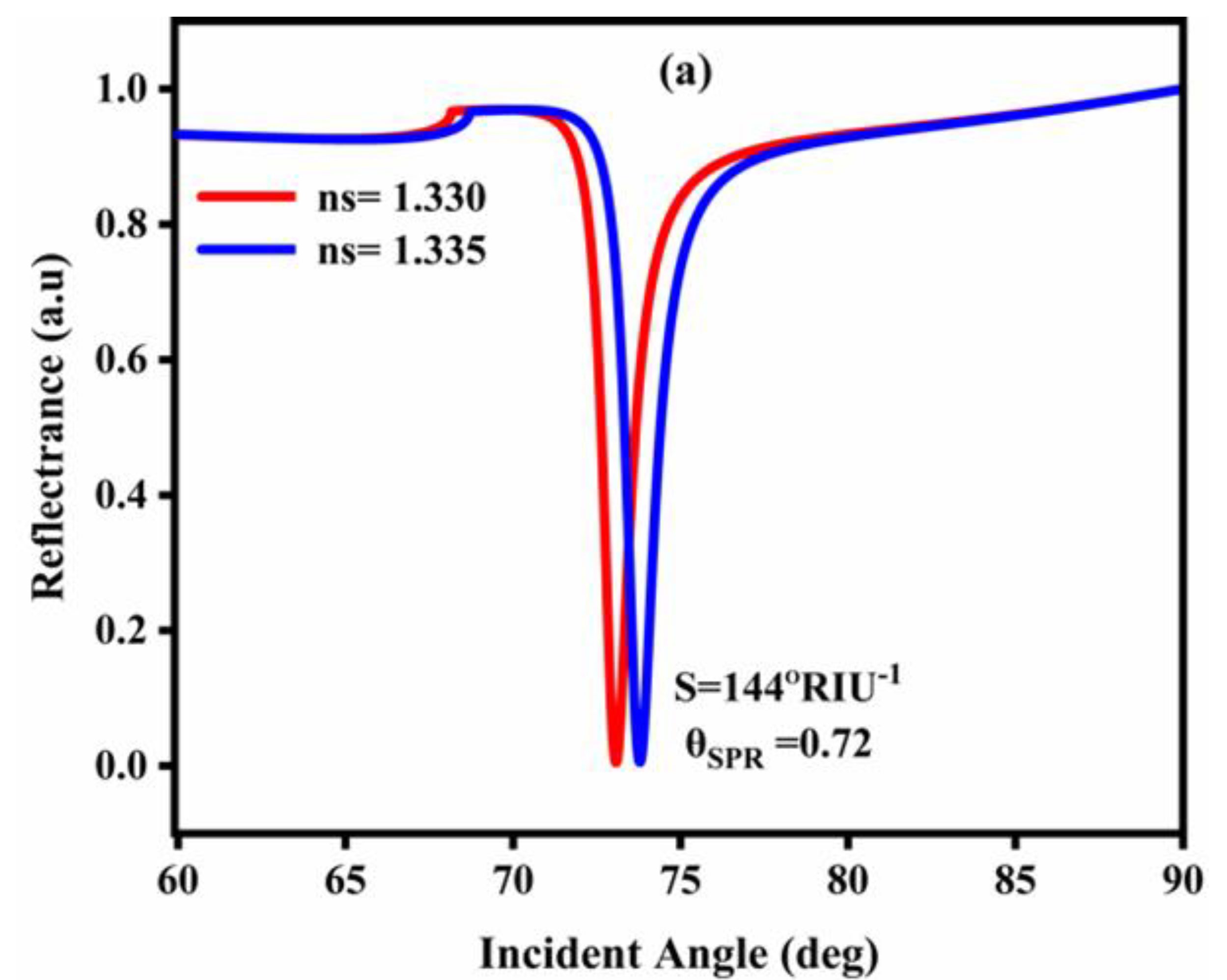
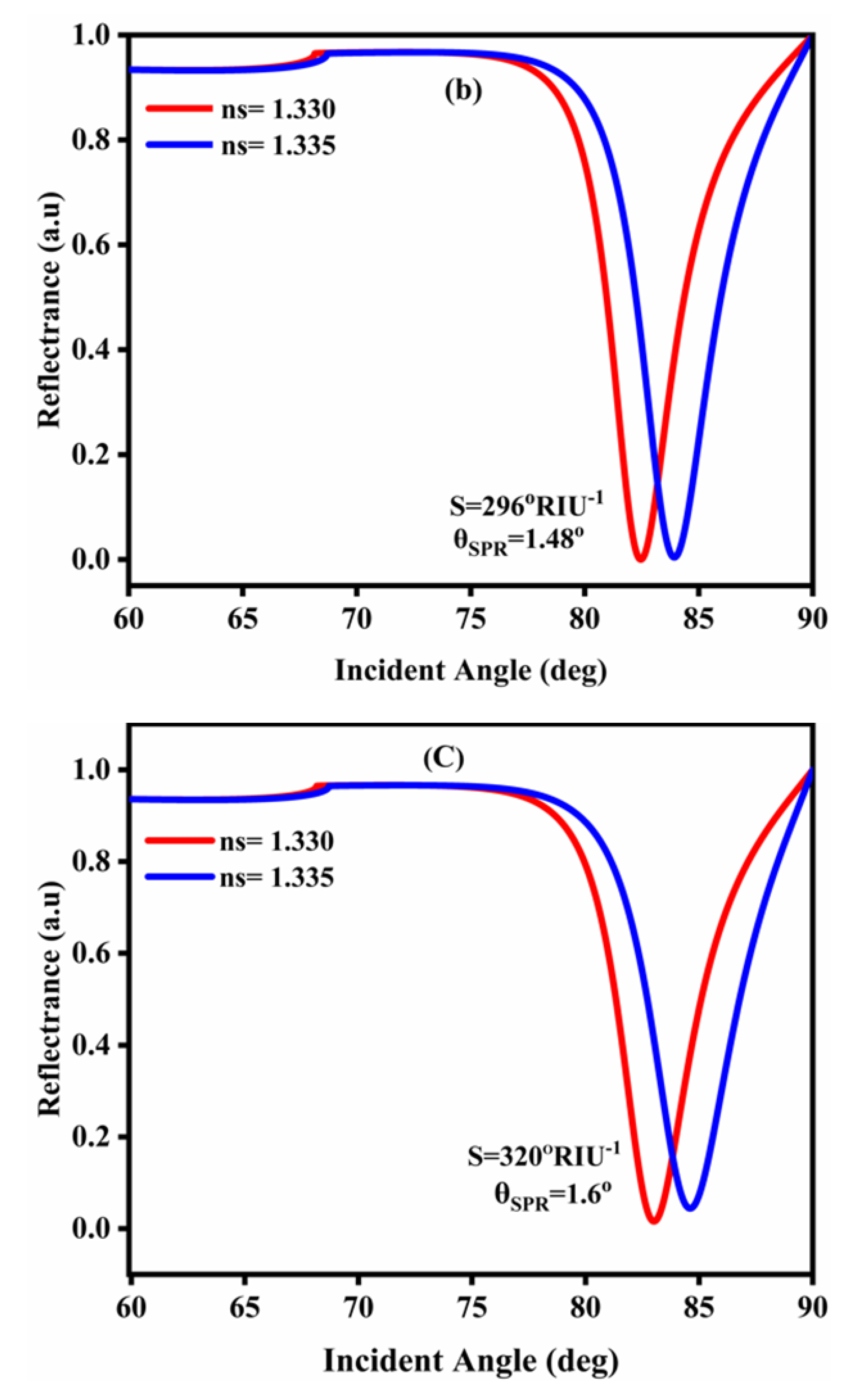
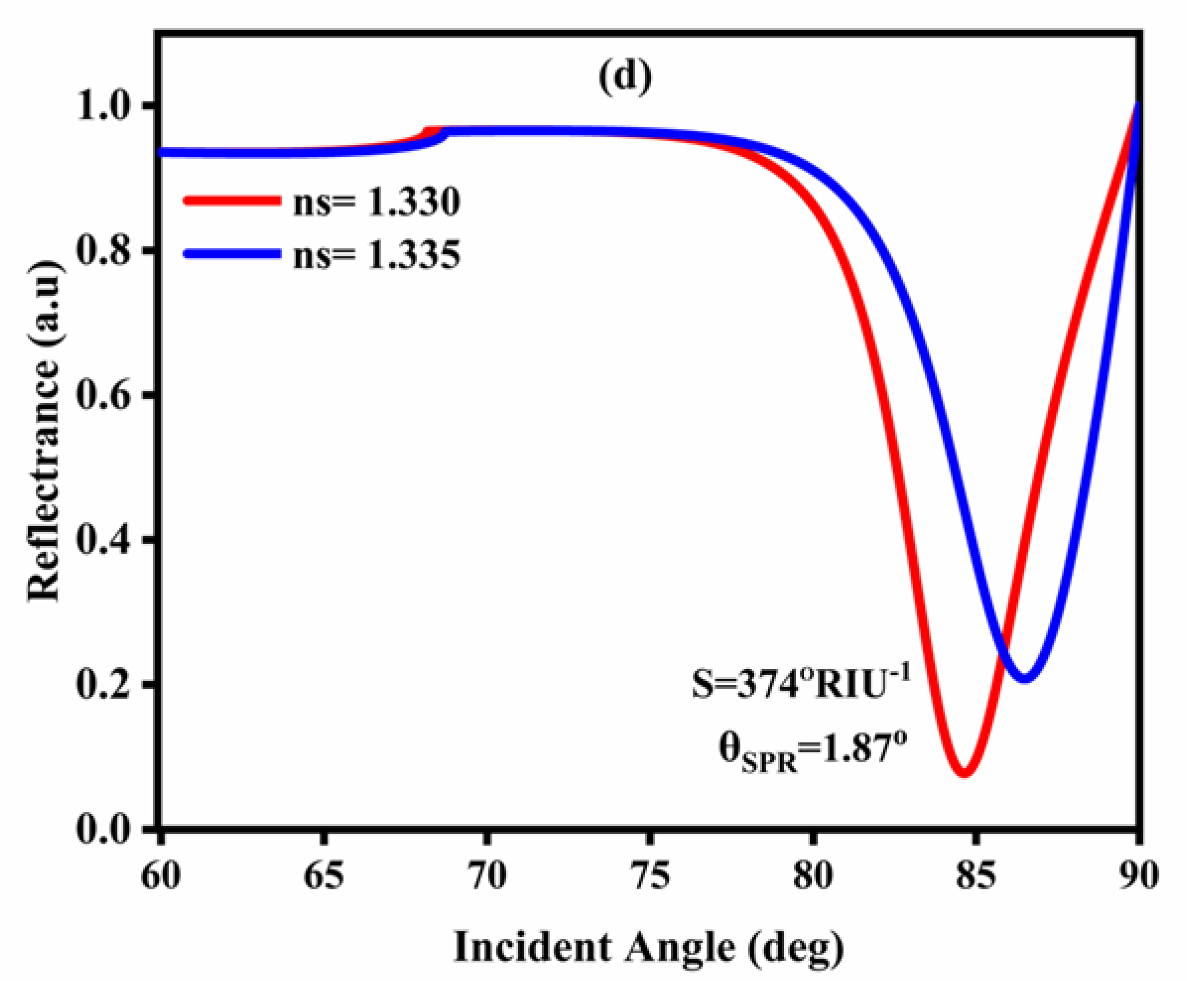
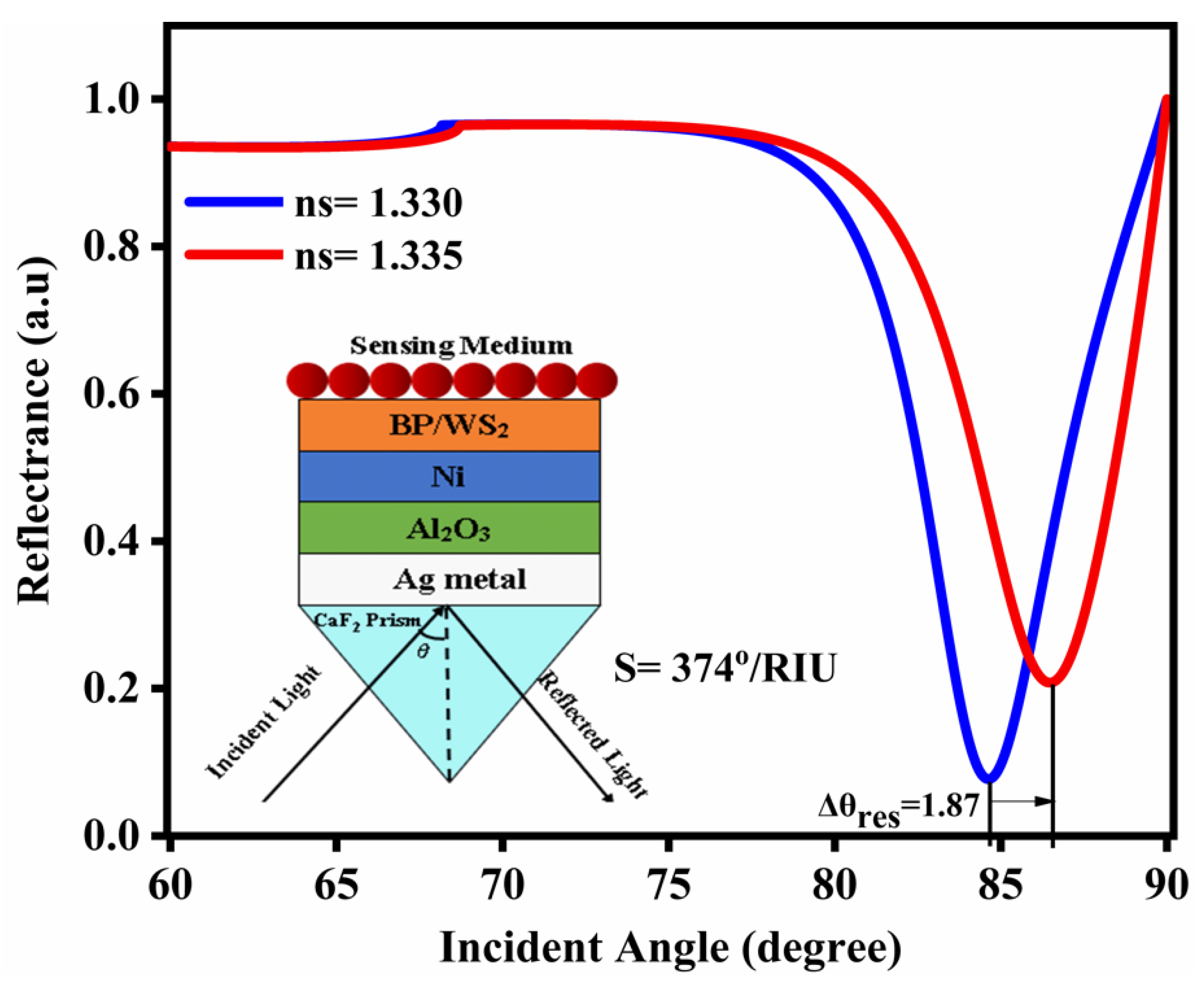
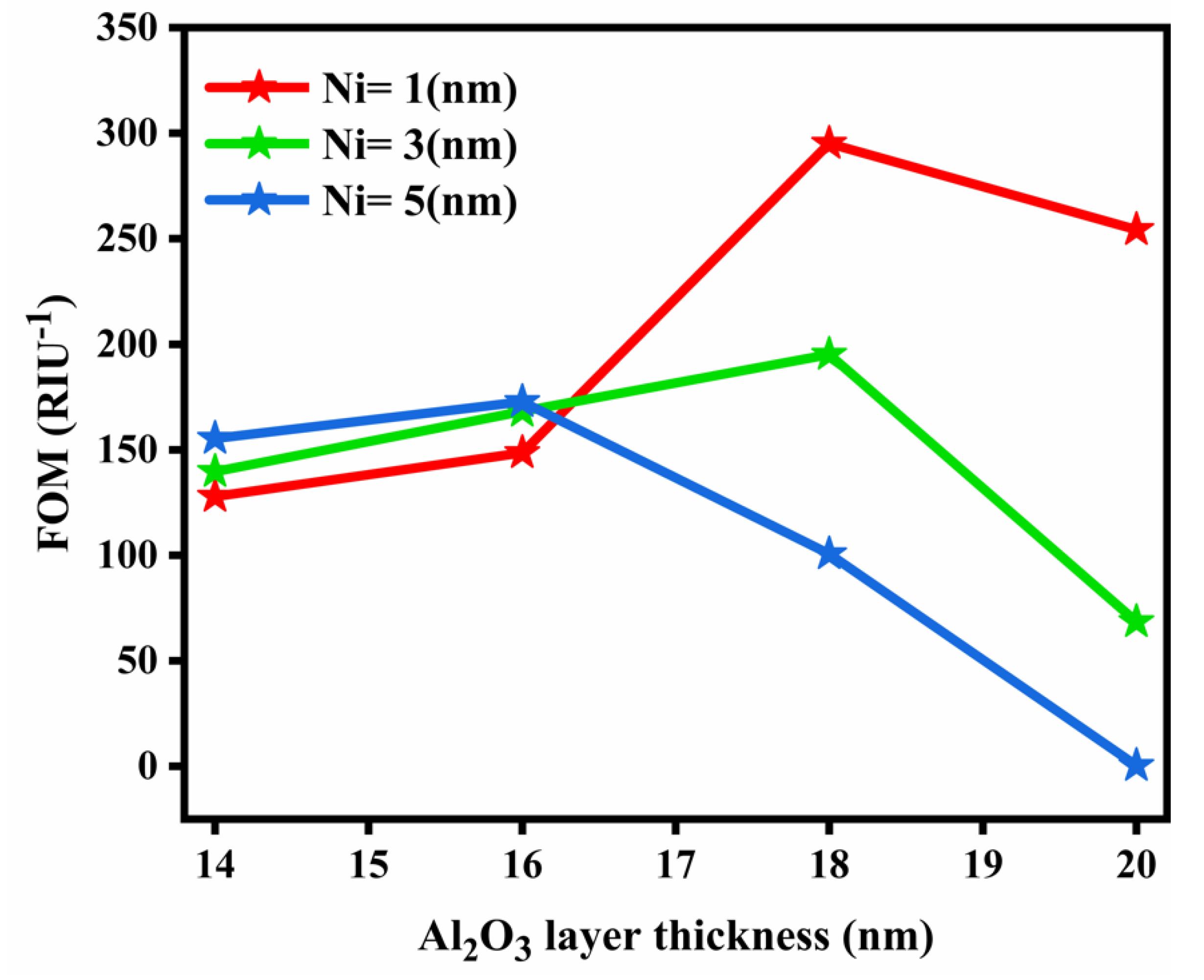
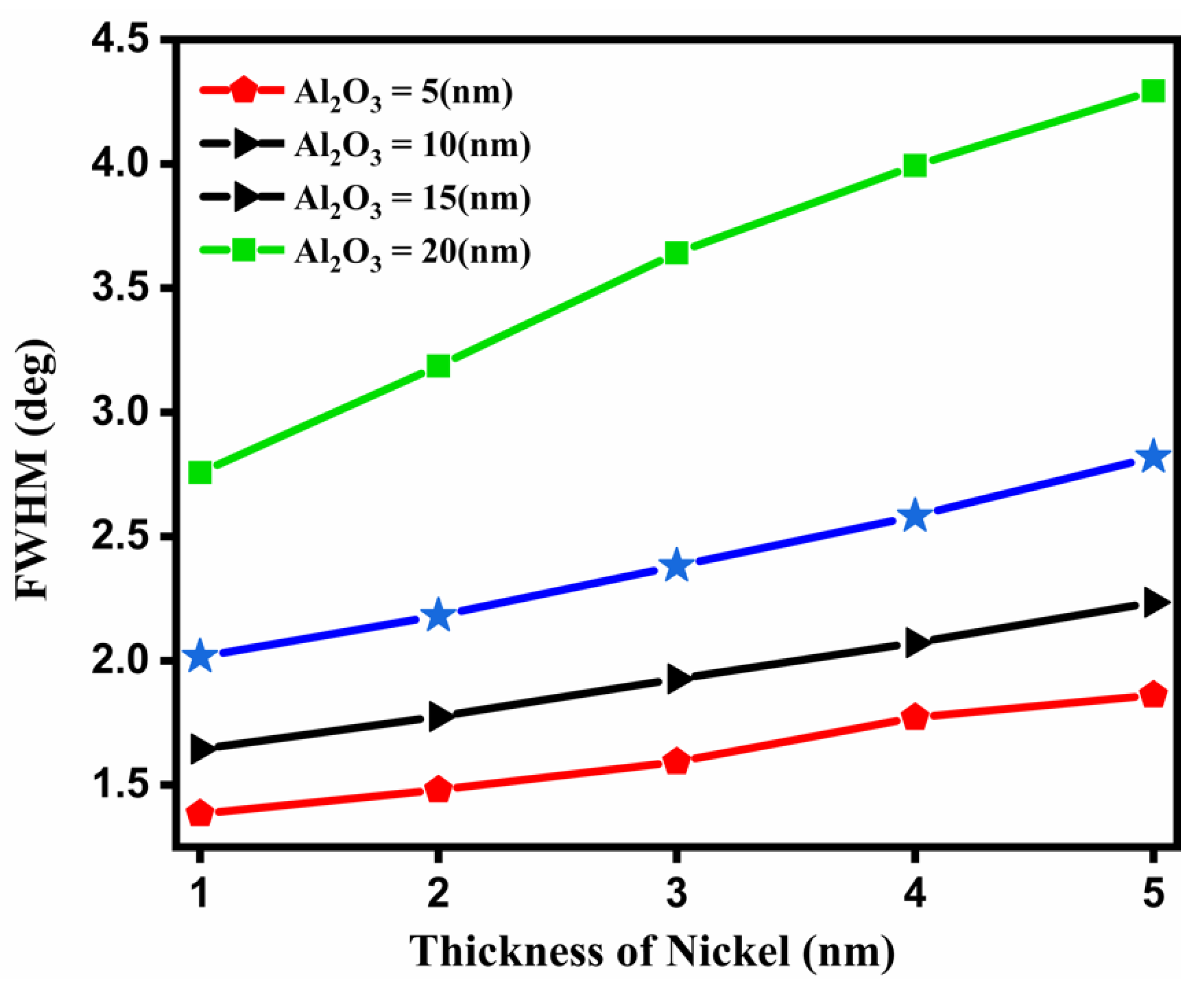
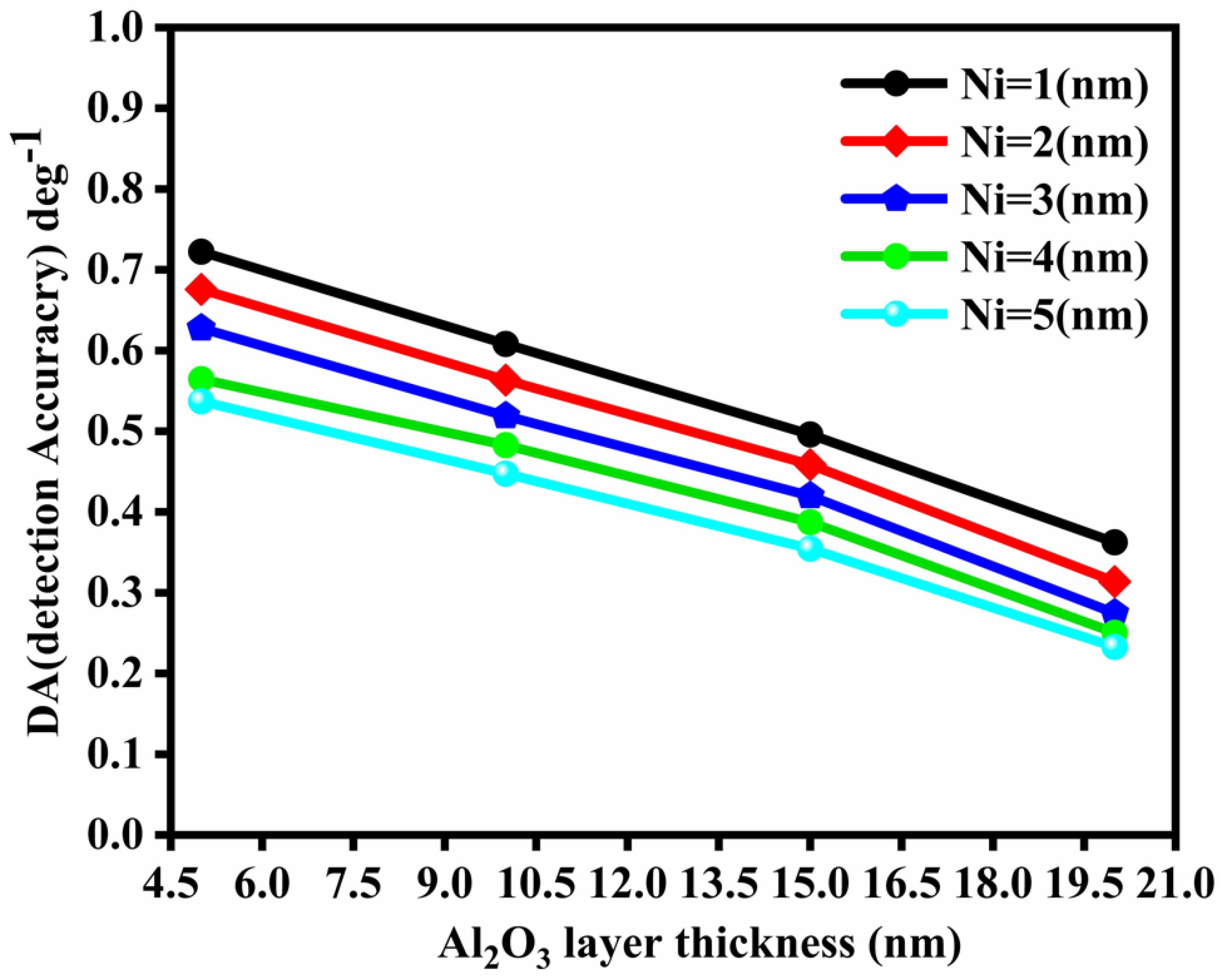
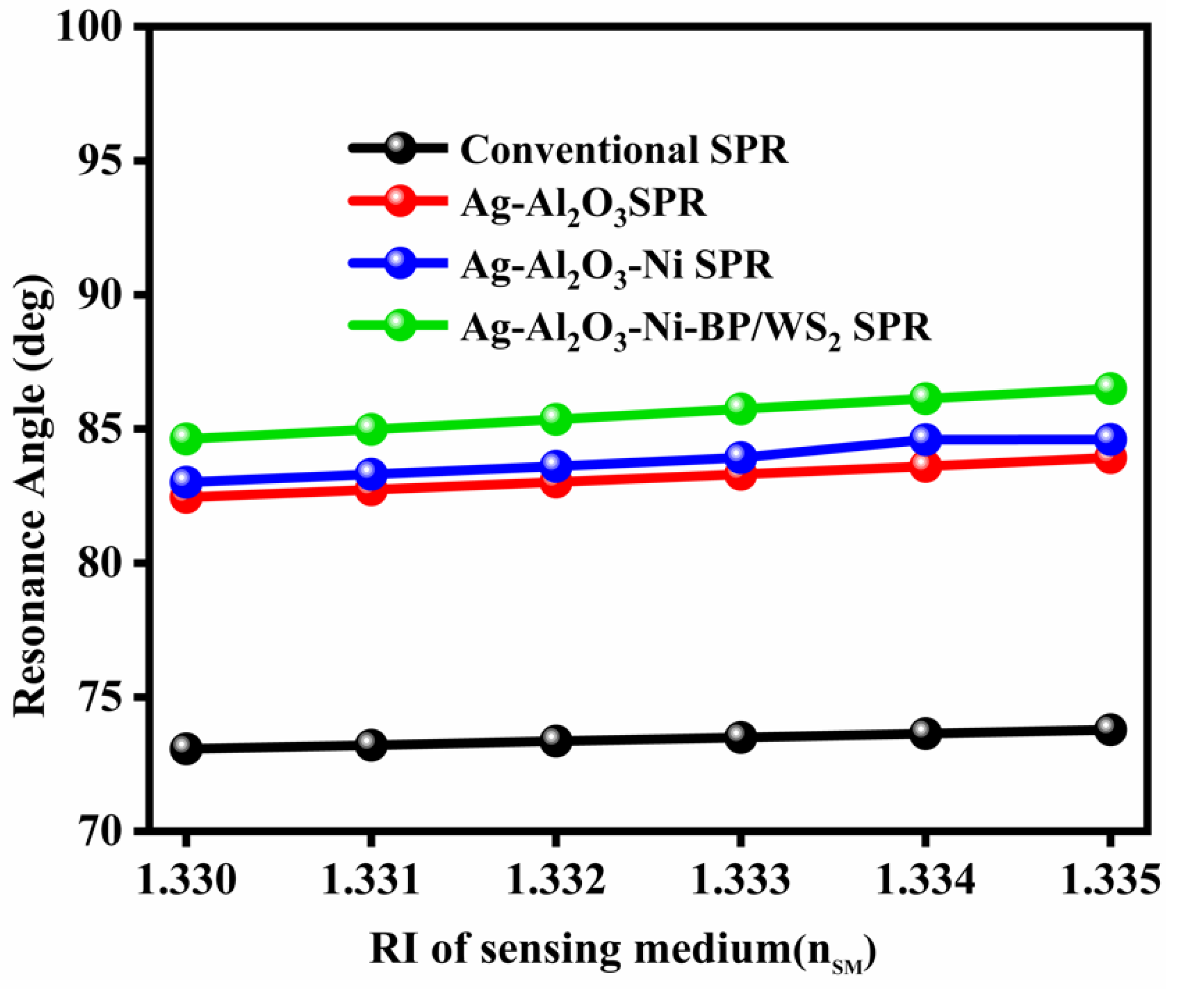
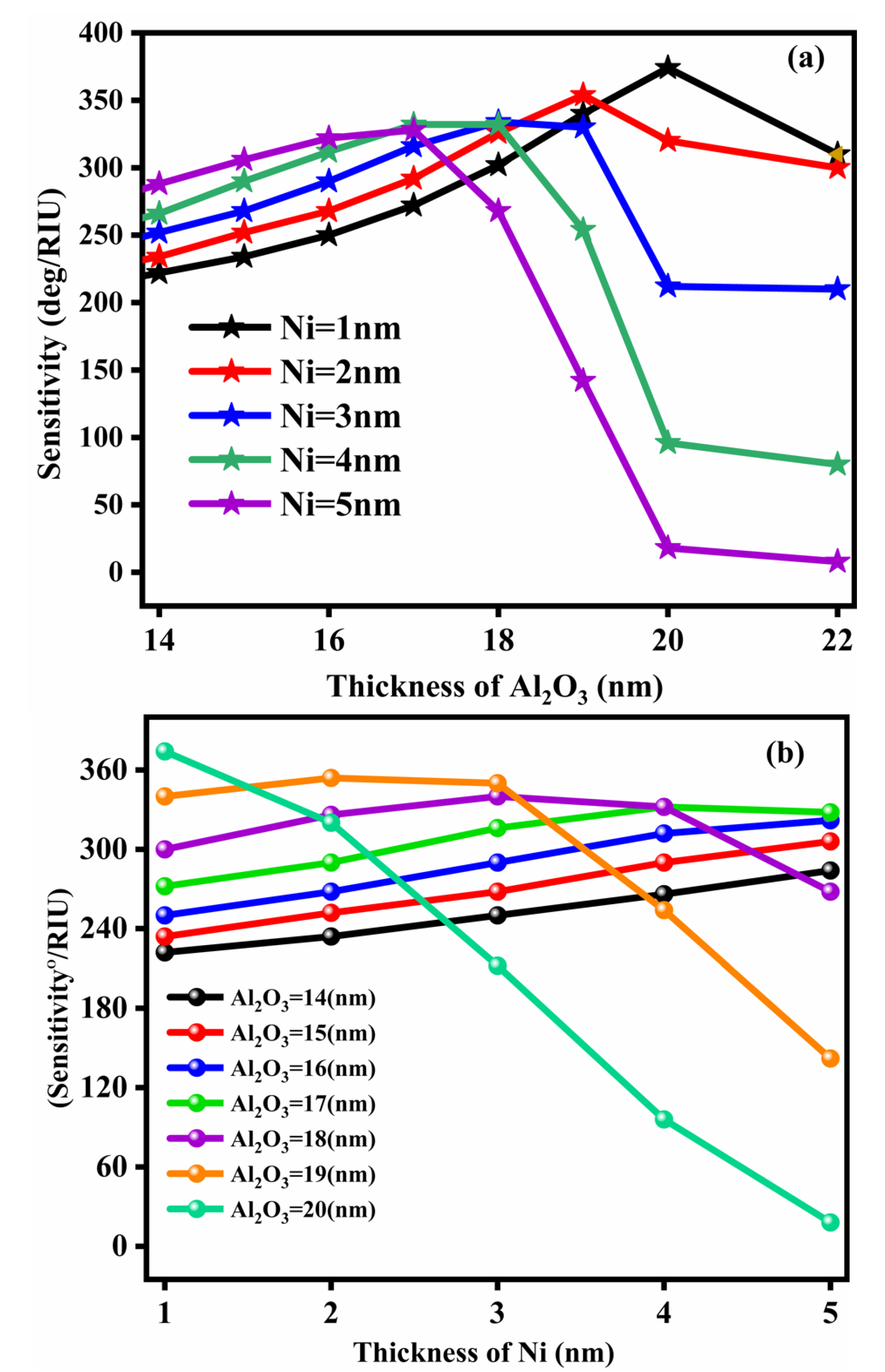
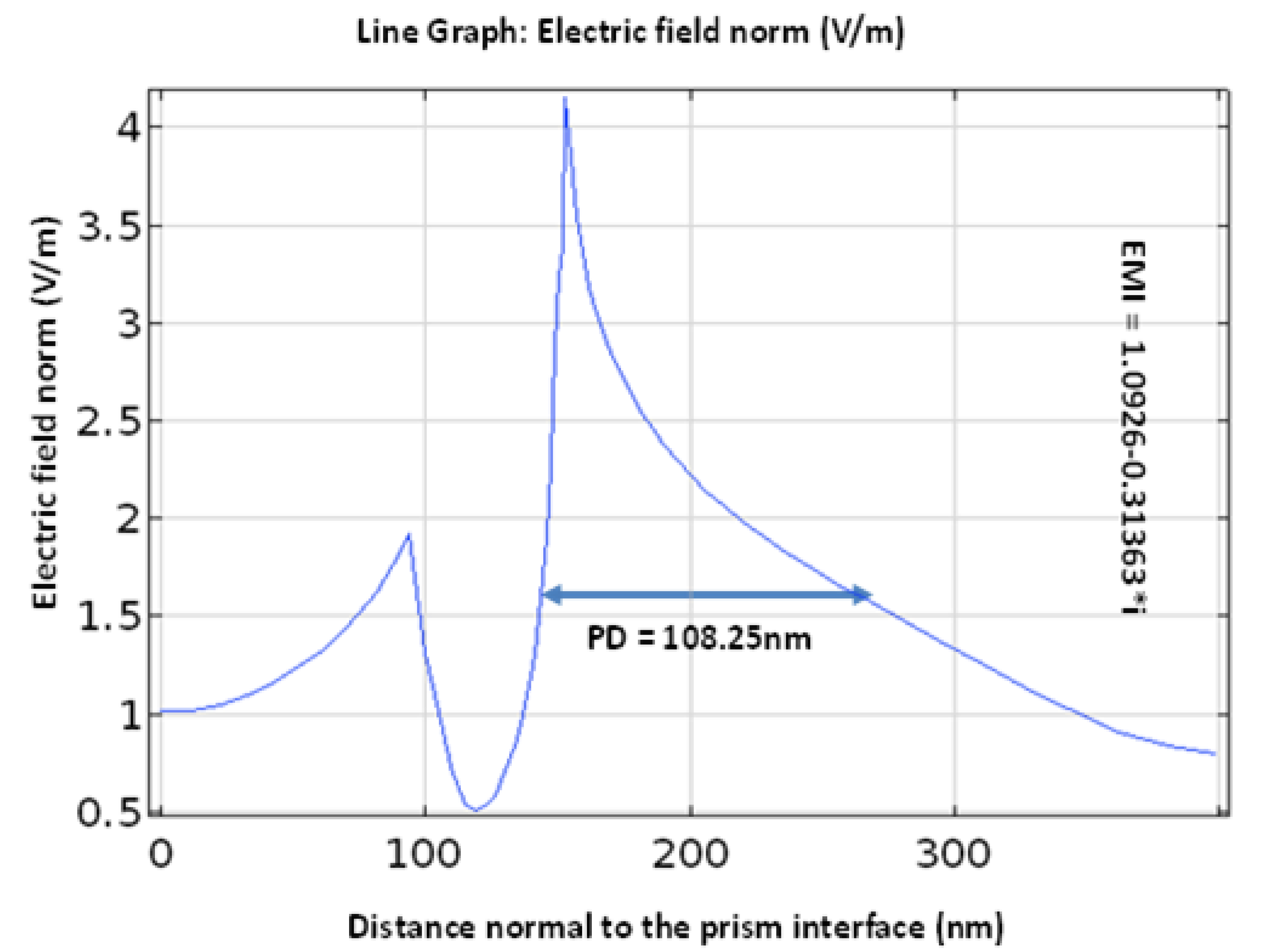
| Materials Used | Thickness (nm) | Refractive Index | References | |
|---|---|---|---|---|
| 1 | CaF2 prism | 100 | 1.4329 | [28] |
| 2 | Ag metal | 50 | 0.0803 + 1i × 4.234 | [29] |
| 3 | Al2O3 | 20 | 1.7659 | [30] |
| 4 | Nickel | 1 | 0.031957 + 1i × 2.693 | [31] |
| 5 | BlueP/WS2 | 0.75 | 2.48 + 1i × 0.170 | [32] |
| 6 | Sensing medium | 300 | 1.330 to 1.335 | This work |
| Device Structure | Assembling of Films |
|---|---|
| design 1 (Conventional SPR) | CaF2 crystal/Ag film/SM |
| design 2 | CaF2 crystal/Ag film/Al2O3/SM |
| design 3 | CaF2 crystal/Ag film/Al2O3/Ni/SM |
| design 4 (Proposed SPR) | CaF2 crystal/Ag film/Al2O3/Ni/BlueP/WS2/SM |
| Device Structure | Δθ (deg) | Sensitivity (° RIU−1) | FWHM (deg) | DA (deg−1) |
|---|---|---|---|---|
| Structure 1 | 0.72 | 144 | 1.04677 | 0.95531 |
| Structure 2 | 1.48 | 296 | 2.05852 | 0.48578 |
| Structure 3 | 1.6 | 320 | 2.25936 | 0.44260 |
| Structure 4 (Proposed work) | 1.87 | 374 | 2.75132 | 0.36346 |
| d(Al2O3) (nm) | d(Ni) (nm) | Δθ (deg) | S (°RIU−1) | DA (deg−1) | FWHM (deg) | FOM (RIU−1) |
|---|---|---|---|---|---|---|
| 14 | 1 | 1.11 | 222 | 0.5190 | 1.9265 | 127.910 |
| 16 | 1 | 1.25 | 250 | 0.4753 | 2.1035 | 148.560 |
| 18 | 1 | 1.51 | 302 | 0.6471 | 1.5451 | 295.122 |
| 20 | 1 | 1.87 | 374 | 0.3635 | 2.7502 | 254.293 |
| 14 | 3 | 1.26 | 252 | 0.4399 | 2.2728 | 139.698 |
| 16 | 3 | 1.45 | 290 | 0.4000 | 2.2499 | 168.219 |
| 18 | 3 | 1.67 | 334 | 0.3498 | 2.8582 | 195.150 |
| 20 | 3 | 1.06 | 212 | 0.3048 | 3.2808 | 68.4950 |
| 14 | 5 | 1.44 | 288 | 0.3746 | 2.6690 | 155.381 |
| 16 | 5 | 1.61 | 322 | 0.3333 | 2.9995 | 172.834 |
| 18 | 5 | 1.34 | 268 | 0.2803 | 3.5672 | 100.670 |
| 20 | 5 | 0.09 | 18 | 0.2376 | 4.2070 | 0.38506 |
Publisher’s Note: MDPI stays neutral with regard to jurisdictional claims in published maps and institutional affiliations. |
© 2022 by the authors. Licensee MDPI, Basel, Switzerland. This article is an open access article distributed under the terms and conditions of the Creative Commons Attribution (CC BY) license (https://creativecommons.org/licenses/by/4.0/).
Share and Cite
Shivangani; Alotaibi, M.F.; Al-Hadeethi, Y.; Lohia, P.; Singh, S.; Dwivedi, D.K.; Umar, A.; Alzayed, H.M.; Algadi, H.; Baskoutas, S. Numerical Study to Enhance the Sensitivity of a Surface Plasmon Resonance Sensor with BlueP/WS2-Covered Al2O3-Nickel Nanofilms. Nanomaterials 2022, 12, 2205. https://doi.org/10.3390/nano12132205
Shivangani, Alotaibi MF, Al-Hadeethi Y, Lohia P, Singh S, Dwivedi DK, Umar A, Alzayed HM, Algadi H, Baskoutas S. Numerical Study to Enhance the Sensitivity of a Surface Plasmon Resonance Sensor with BlueP/WS2-Covered Al2O3-Nickel Nanofilms. Nanomaterials. 2022; 12(13):2205. https://doi.org/10.3390/nano12132205
Chicago/Turabian StyleShivangani, Maged F. Alotaibi, Yas Al-Hadeethi, Pooja Lohia, Sachin Singh, D. K. Dwivedi, Ahmad Umar, Hamdah M. Alzayed, Hassan Algadi, and Sotirios Baskoutas. 2022. "Numerical Study to Enhance the Sensitivity of a Surface Plasmon Resonance Sensor with BlueP/WS2-Covered Al2O3-Nickel Nanofilms" Nanomaterials 12, no. 13: 2205. https://doi.org/10.3390/nano12132205
APA StyleShivangani, Alotaibi, M. F., Al-Hadeethi, Y., Lohia, P., Singh, S., Dwivedi, D. K., Umar, A., Alzayed, H. M., Algadi, H., & Baskoutas, S. (2022). Numerical Study to Enhance the Sensitivity of a Surface Plasmon Resonance Sensor with BlueP/WS2-Covered Al2O3-Nickel Nanofilms. Nanomaterials, 12(13), 2205. https://doi.org/10.3390/nano12132205










